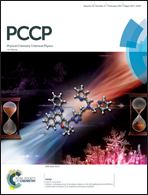Hydrogen diffusion into the subsurfaces of model metal catalysts from first principles
Abstract
Diffusion pathways of atomic hydrogen on model catalyst surfaces and into subsurfaces are of great significance in the exploration of novel catalytic hydrogenation in heterogeneous catalysis. We present in detail the diffusion pathways of hydrogen on seven different open and closed model catalyst surfaces from first principles calculations. Seven transition metal catalysts with thirteen different crystal surfaces, i.e., Co(001), Ni(100) and Ni(111), Pd(100) and (111), Pt(100) and (111), Cu(100) and (111), Ag(100) and (111) and Au(100) and (111), are taken into account. Thirteen corresponding potential energy surfaces (PESs) are constructed for modelling hydrogen diffusion on these model catalyst surfaces and into the subsurfaces by interpolating ab initio density functional theory energy points (∼2000 for each surface). The minimum energy diffusion pathways for hydrogen on the surfaces and into the subsurfaces are globally searched for based on PESs using a mesh method, and are in excellent agreement with those calculated from the nudged elastic band method. Furthermore, the important substrate relaxation effect can decrease the diffusion barriers for hydrogen into catalyst subsurfaces. The high reactivity of subsurface reactants mainly comes from the residual energy of subsurface hydrogen emerging from the subsurface onto the surface.



 Please wait while we load your content...
Please wait while we load your content...